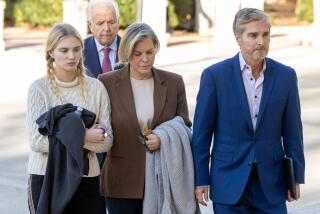Sight Lines at Murder Scene Reexamined
- Share via
Twenty years after Bruce Lisker was convicted of fatally beating and stabbing his mother in the family’s Sherman Oaks home, state attorneys, forensic experts and others went to the crime scene Saturday to reexamine a key element of the case that put him in prison.
The unusual step was taken to test whether Lisker could have seen his critically wounded mother, Dorka, lying motionless on the floor from a window at the back of the house, as he told police he had on the day of the killing in 1983.
At trial, the prosecutor said it was physically impossible and proof that Lisker, then a teenager, was lying.
In March, after conducting a reenactment with Times reporters, former prosecutor Phillip H. Rabichow, now retired, acknowledged that his argument to the jury in 1985 was wrong and that Lisker might have been able to see his mother as he had said.
Lisker, who was arrested the day of the killing, was convicted of first-degree murder in 1985 and sentenced to life in prison. Now 40, he is seeking to have his conviction overturned in federal court.
On Saturday, two teams of crime scene experts, one for Lisker’s defense and the other for the state attorney general, sought to conduct tests.
They spent four hours at the residence measuring the interior and conducting experiments based on evidence presented at trial.
“There’s no doubt that he could have seen his mother, even from where the prosecution says she laid,” said William Genego, one of Lisker’s attorneys, who was present for the reenactment.
Deputy Atty. Gen. John Yang, one of the lawyers defending Lisker’s conviction, said only that he and a colleague were at the house “to do some measurements.” He said he would not respond to Genego’s statement that Lisker could have seen his mother.
“I have to reserve comment because of the ongoing litigation,” Yang said.
Asked whether he was concerned about the outcome of the reenactment, he said, “No comment.”
Genego said experts for the attorney general’s office were able to use old crime scene photographs to pinpoint where the prosecution said Lisker stood outside a sliding glass window March 10, 1983.
The photos were offered as evidence intended to prove that Lisker could not have seen his mother because his view would have been blocked by a dining room table and a stone planter in the entry hall.
The results of Saturday’s experiment will be offered during a federal court hearing in December, when Lisker’s lawyers intend to argue that their client was unjustly convicted, Genego said.
Other elements of the prosecution’s case against Lisker have proved wrong over the last two years.
For example, a bloody footprint in a bathroom that the prosecutor attributed to Lisker was recently reanalyzed by the Los Angeles Police Department and found not to have been made by Lisker’s shoe.
Another apparent shoe impression discovered on the victim’s head was also determined not to have been made by Lisker’s shoe, but was “similar in size and dimension” to the bathroom print.
Lisker’s lawyers contend that police prematurely dismissed an alternate suspect who had provided a false alibi for the day of the killing and had a history of violence.
That young man, a friend of Lisker’s, killed himself in 1996.
The current homeowners agreed to let Lisker’s attorneys and lawyers from the state attorney general’s office into their home, as they had for The Times.
Although both sides had wanted to conduct their own experiments privately, the homeowners decided to give them access to the residence at the same time.
More to Read
Sign up for Essential California
The most important California stories and recommendations in your inbox every morning.
You may occasionally receive promotional content from the Los Angeles Times.











